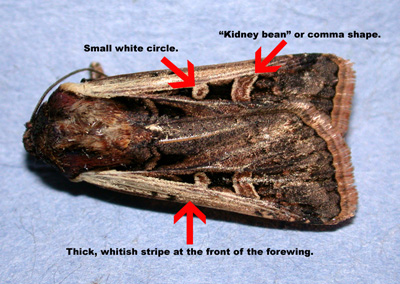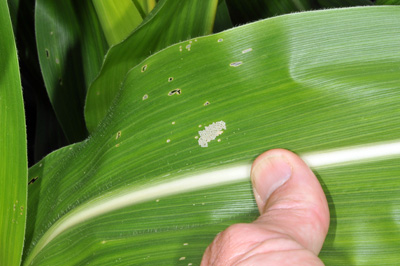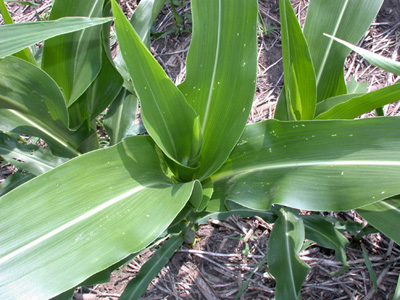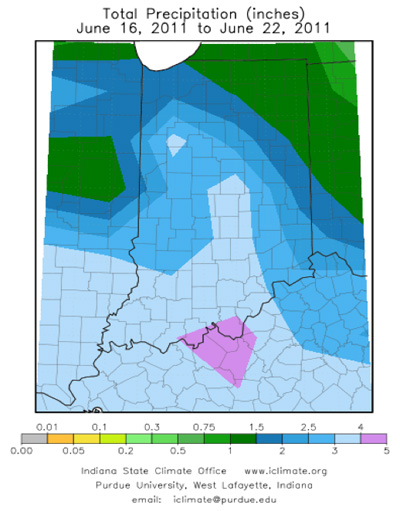- Western Bean Cutworm Moth Flight Begins
- Request for Help in Obtaining Western Bean Cutworm Egg Masses
- European Corn Borer Questions Continue
- Black Light Trap Catch Report
Western Bean Cutworm Moth Flight Begins – (Christian Krupke and John Obermeyer)
• Moths emerging from soil, soon mating and egg laying will begin.
• Scouting for egg masses should commence once moth captures are increasing daily.
• Most Bt corn is protected, but don't forget the refuge.
Pheromone trapping began for western bean cutworm moths on Monday (June 20), and sure enough some were captured that very night. This is the beginning of an extended moth emergence and flight, with their peak presence expected in the 3rd week of July, a bit later than last year as a result of the cooler April and May temperatures this year. Those in high-risk areas, i.e., sandy soils, high moth flight and WBC history, should be gearing up for field scouting of vulnerable cornfields.
Scouting should begin once moths are being captured nightly. In five different areas of a field, inspect 20 consecutive plants for egg masses which are laid on the upper surface of the top leaves of corn and/or larvae that may have hatched and crawled to the whorl and begun to feed. Usually the newest, vertical leaf is the best place to look. Young larvae need pollen to survive, and female moths are most attracted to cornfields that are just about to pollinate. Since very few, if any fields are that far developed, moths will lay eggs on whorl stage corn. Damage from larvae, as they feed deep in the whorl (attacking the tassel to get at pollen), will resemble corn borer or fall armyworm damage. Initially the damage will be subtle and not economically important, as the larvae grow so will their mouthparts and appetite. Because the proteins expressed in Herculex, Smartstax, and Viptera has shown to be very effective in suppressing this pest, scouting should not be necessary in those fields, other than for informational purposes for next years planting etc. But don't forget the refuge corn - obviously it is not protected.
Key identifying characteristics of WBC moth
![]()
Request for Help in Obtaining Western Bean Cutworm Egg Masses - (Nicole Parker)
Western bean cutworm season is upon us, and as graduate student in the Field Crops Entomology lab at Purdue with Dr. Christian Krupke, I am anxiously awaiting for their presence to be felt. Western bean cutworm are an integral and essential piece of the research I am working on at Purdue, which focuses on the potential impact that larvae have on ear rot development in field corn. As a result I need to collect several thousand egg masses. This will require finding fields that are highly infested with western bean cutworms. Should you find a significant amount of egg masses in your fields, please send an email to ckrupke@purdue.edu so that the Field Crops crew can come and help you get rid of them!
Leaf with a WBC egg mass and feeding scars from small larvae in the whorl
![]()
European Corn Borer Questions Continue - (Christian Krupke and John Obermeyer)
• ECB exploiting unprotected corn and other crops.
• Tried and tested threshold, still applicable today.
It has probably been over ten years since we've had questions about scouting and treating for European corn borer (ECB). This is not to indicate that mass destruction by this old pest is occurring, but in some non-Bt cornfields, folks are finding significant damage.
To sample for ECB, inspect 20 consecutive plants in each of 5 areas of the field. Randomly select the first plant of each sample set. Carefully examine the whorl leaves on each plant. Count and record the number of plants showing foliar feeding damage. Total the number of plants showing such damage to determine the percentage of damaged plants. Also, determine if borers are still present and actively feeding. Pull out, carefully unroll, and examine the whorl leaves from one plant showing damage in each sample set.
Treatment decisions; below is a dynamic threshold that was developed years ago. For years, producers would consider about 50% infestation as treatable. And in those years corn prices hovered around $2/bushel. But we can still use this dynamic equation today: If you plug in your specific variables in the following formula you will find treatment levels have changed along with the price of corn. Interestingly for us IPM practitioners, the price of corn has gone up and the cost of treatments has gone down (generics are part of this trend). Both factors act to effectively lower our treatment threshold, so what was tolerated just a few years ago just does not make economic sense anymore. An example appears below.
1) Preventable yield loss (bu/A) = anticipated yield (bu/A) X yield loss figure (following table) X level of infestation (as a decimal value, so 10% = 0.10) X anticipated level of control (as a decimal value). It is probably impractical to expect 100% control. A good estimate of control might be 75%.
2) Preventable dollar loss/A = Preventable yield loss (bu/A) X market value ($/bu).
3) Compare preventable dollar loss/A to cost of insecticide and application to determine if treatment is warranted.
| Yield Losses Caused by European Corn Borers for Various Corn Growth Stages1 | |||
| Yield loss - #borers/plant2 | |||
| 1 | 2 | 3 | |
| Early whorl | 5.5% | 8.2% | 10.0% |
| Late whorl | 4.4% | 6.6% | 8.1% |
| Pre-tassel | 6.6% | 9.9% | 12.1% |
| 1 These percentages are based on physiological stresses and do not include losses due to stalk breakage and/or ear droppage. 2 For more than 3 borers/plant, use percent yield loss figure for 3 borers, or adjust loss slightly upward. |
|||
Example: A field in the early whorl stage has 35% of the plants with "shot-hole" feeding and an average of 1 live larva per whorl. Anticipated yield is 180 bu/A and the crop is valued at $7.00 per bushel. The cost of the insecticide and application is $15.00 and 75% control can be expected. Would it pay to apply the insecticide?
1) Preventable yield loss (bu/A) = 180 bu/A X .055 (5.5% loss for 1 borer/plant) X .35 (35% infestation) X .75 (75% control) = 2.6 bu/A
2) Preventable dollar loss/A = 2.6 bu/A X $7.00/bu = $18.19/A
3) Compare preventable dollar loss/A with cost of control/A
$18.19/A (preventable $ loss/A) - $15.00/A (cost of control) = $3.19/A return from application of control. The most likely decision in this case would be spray away!
Shot-fole feeding, is it ECB or WBC?
![]()
Click here to see the Black Light Trap Catch Report
![]()






